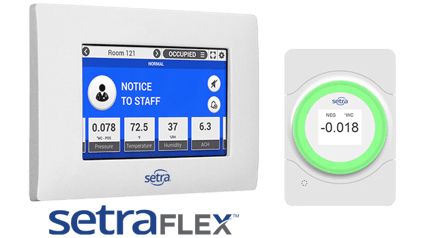We recently interviewed one of our sales managers about the Setra Lite. He answered some of the most common questions around this innovate product.
What are the top applications for the Setra Lite?
The top applications for Setra Lite are in the healthcare industry. It's designed for ASHRAE 170 spaces Setra hasn't traditionally focused on, such as sterile storage, linen closets, hazardous storage, and some compounding pharmacy areas. Whether they're already measuring or looking to measure differential pressure, Setra Lite gives a local visual indication of said pressure so these spaces have more than a remote BMS readout. Depending on the application, an actual readout of the pressure differential or a visual indication of good or bad, which in healthcare is usually green or red, could be necessary.
What value does Setra Lite bring to hospitals?
Setra Lite can be a cost-effective solution to labor intensive manual room pressure testing. Many hospitals currently do tissue or "flutter strip" testing, which involves a person walking to each room with a tissue to check if the room is negatively or positively pressurized. From a labor standpoint, Setra Lite is a highly reliable and efficient way to visually identify whether or not a space is properly pressurized.
What feature are you most excited about on the Setra Lite?
I hear from facilities managers and engineers, maintenance personnel, and even circulating nurses that they don't know in the moment if these spaces are actually properly pressurized; to know, they have to rely on the occasional tissue or flutter strip test. The Setra Lite allows them to see at a glance if the room is properly pressurized without waiting for the results from time-consuming and periodic manual testing. It's an inexpensive device designed to add value for our customers.
Why would someone purchase Setra Lite if they already have Setra FLEX or another room pressure monitor?
Think of the Setra Lite as less of a room pressure monitor and more of a visual pressure indicator. This is to say that is when you have a FLEX, you're looking for something that's a full-featured environmental room pressure that allows you to tie in values beyond pressure like temperature and humidity, particle counting, and air changes per hour to name a few. With Setra Lite, we've taken Setra's well-known and trusted differential pressure sensor and added a bright, clear indication as to whether the room is properly pressurized according to the set values. Lite is a much less expensive solution to displaying pressure in spaces where it isn't economically feasible or necessary to have a full-featured room pressure monitor.
And you can tie Setra Lite into Setra FLEX, correct?
That's correct. Again, think of Setra Lite as a glorified DPT. It can tie into Setra FLEX like a 264 or 265 differential pressure transducer, and it can also be a standalone device giving a local visual pressure indication. Setra Lite is an analog output device that can be tied into a controller or tied into FLEX to see readouts in your BMS.
Can Setra Lite replace a room pressure monitor in a space like an operating room?
The short answer is that's not really what it was designed for. Consider what the end user, that doctor, that circulating nurse, needs to see in the OR space. The Setra Lite isn't designed for an operating room, except possibly as a secondary pressure indicator and/or if an additional external DPT is required. If there are multiple doors to an operating theater, a FLEX may not be necessary at every single entrance; a secondary pressure transducer at the other entries might be sufficient. A Setra FLEX at the primary entrance or primary use station and Setra Lite at other doors or use stations could the right solution to ensure proper pressurization.
How would you know if a space requires Lite or a traditional room pressure monitor? Where would you make that delineation?
If someone is torn between whether an application needs a room pressure monitor or Setra Lite, decide what features are essential and how it needs to integrate into the building management system. Most hospitals, surgery centers, laboratories, and compounding pharmacies will be able to determine whether FLEX or Lite or a combination of the two is necessary for their spaces.
Setra Lite is certainly an innovative product with not too many comparable products out there quite like it. How does it compete against more mechanical devices currently on the market?
In most cases, Setra Lite is less expensive than these mechanical devices. Lite isn't a device you hope is working and have no way of verifying it's working without constantly testing it. You know Setra Lite is working if it has power connected to it. It's the simple yet refined 21st century version of these mechanical devices.


